Last Updated on December 29, 2025
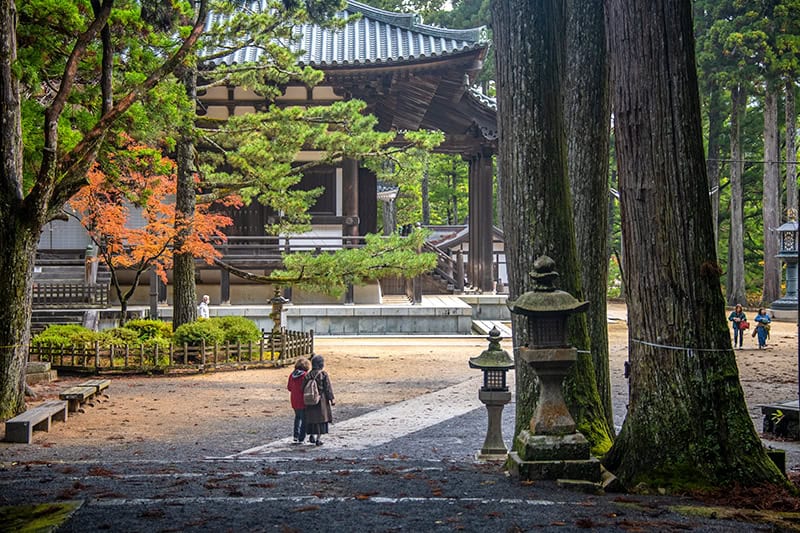
Most travelers find the enormous contrast between the modern and the ancient fascinating when they visit Japan.
Tokyo, for example, the bustling high-tech capital of nearly 14,000,000, represents all that modern Japan has to offer. A city of neon and chrome, there is no other city like it. If high-tech boasted of a home, Tokyo would be it.
On the other hand, there is ancient Japan. These historic areas speak of the country’s cultural and religious origins over thousands of years, drawing many travelers.
Kyoto is the best-known and most famous of Japan’s cultural and historic cities. A two-hour train ride southwest of the capital, it draws millions of foreign tourists each month—more than double the city’s residents. Like Tokyo, it’s a city that youshouldn’t miss.
On a recent trip to Japan, we wanted to see both cities and experience the country’s ancient and modern attributes. We especially made it a point to visit each city’s cultural events and historic places.
Table of contents
- Planning Our Trip to Koyasan, Japan
- Finding the “Real” Ancient Japan
- A (Very) Short Traveler’s Primer on Japan’s Religions
- Beautiful Koyasan, Japan
- Our Buddhist Monk Tour Guide
- Koyasan, Japan’s Fascinating Cemetery
- More Fascinating Places
- A New Guide, New Sites
- Staying At A Monastery
- How to Get to Koyasan, Japan
- One Final Note
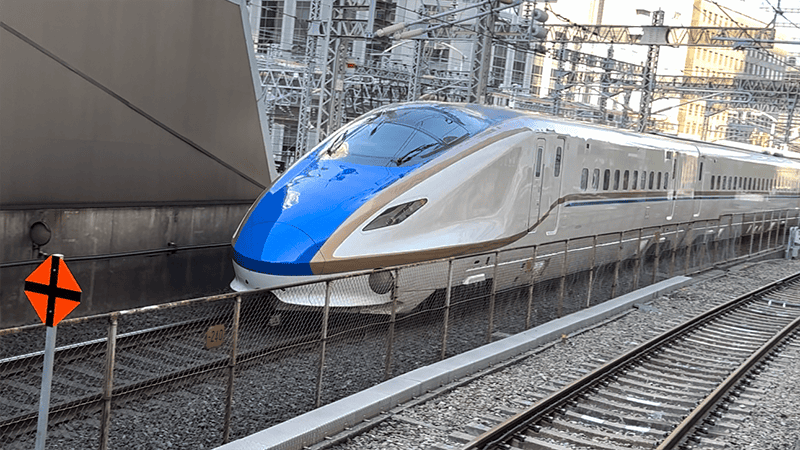
Planning Our Trip to Koyasan, Japan
When we planned our trip to Japan, we sought to experience all that country offered, especially its ancient and modern juxtaposition.
We knew the modern would fall into our laps since we’d visit several large cities. The ancients didn’t appear problematic since we had targeted Kyoto and Nara. (See our article on Kyoto and a video on Nara’s bowing deer here) Both are historical cities well worth visiting, and many travelers visit them. On the other hand, they’ve both been homogenized by the large cities that have enveloped them.
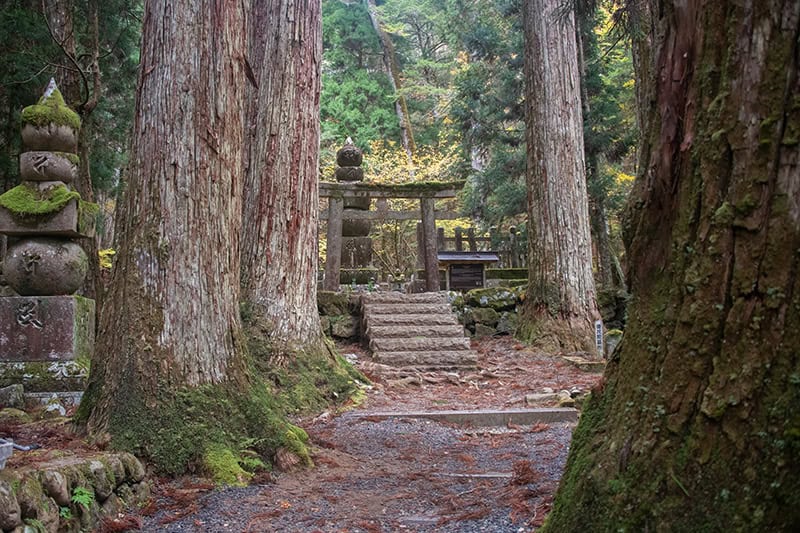
Finding the “Real” Ancient Japan
We realized that modern civilization had diluted the “ancient experience” we sought in those cities. After all, we believed authentic ancient Japan would be difficult to find anywhere tour buses continually shuttle hundreds of people to historical sites.
Then, searching for Japan’s “authentic ancientness,” we discovered Koyasan.
Two hours south of Kyoto, Koyasan (also known as Mount Koya) is the center of the Buddhist religion, Shingon. It’s one of the best places to absorb Japan’s ancient culture, which has remained unchanged over the centuries.
If you’re traveling to Japan and want to see the country’s deep cultural beginnings and its religions, a visit to Koyasan is a must.
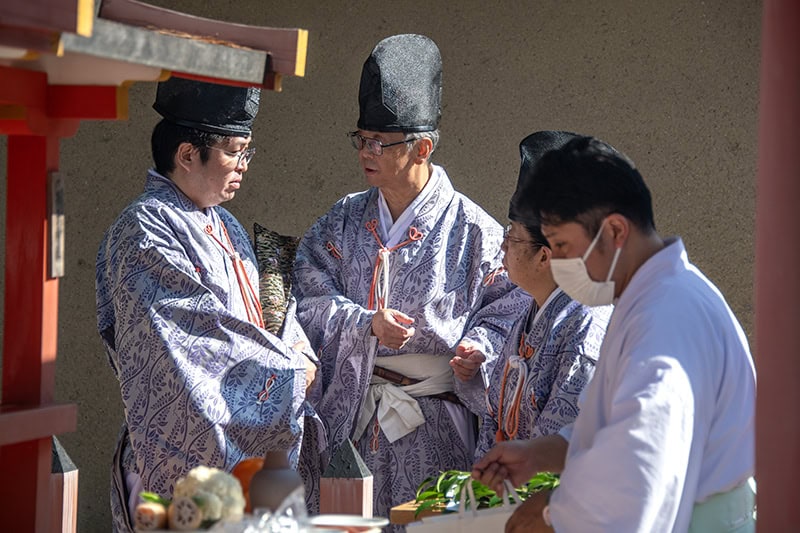
A (Very) Short Traveler’s Primer on Japan’s Religions
If you travel to Japan, to Koyasan or elsewhere, you’ll eventually want to know more about the country’s two prominent religions. This religion primer may help.
Two religions, Shintoism and Existential Buddhism, coexist in Japan. Shintoism worships nature and all that exists. Buddhism, on the other hand, has one deity figure.
Western Judeo-Christian religions are monothetic and require that one practice only one religion. Religion in Japan, however, is unique in that it is non-monothetic.
Surprisingly, many Japanese practice both religions simultaneously, which is why monothetic Western religions have yet to be widely accepted in Japan.
As one Japanese I met on our trip told me, one religion worships life, and the other promises an afterlife: “You live with Shintoism but die a Buddhist.”
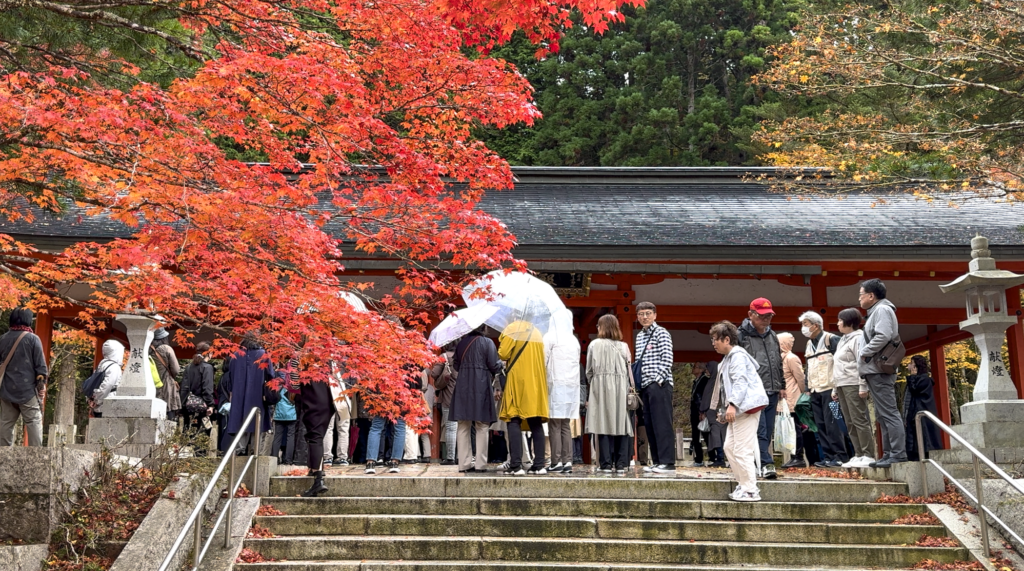
Beautiful Koyasan, Japan
There is no better city to learn about Buddhism and how it relates to Japan’s history and culture than Koyasan and Mount Koya. It is truly an incredible place to visit, whether you find religion of interest or not.
In 816 AD, a monk named Kukai, posthumously named Kobo Daishi, founded Shingon Buddhism and the monastery complex Koyasan. For over 1,200 years, Koyasan has been an active monastic center and one of the most sacred sites in Japan.
In 816, Kobo Daishi established the temple in Koyasan and began teaching Shingon Buddhism. In 2004, more than 1,000 years after his death, UNESCO designated Koyasan a World Heritage Site.
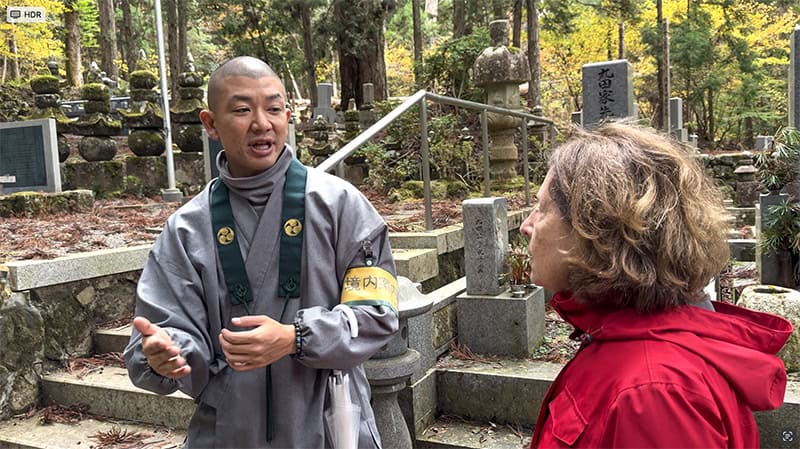
Our Buddhist Monk Tour Guide
Before we left the U.S. for Japan, we arranged to have a Buddhist monk as our tour guide in Koyasan. I’m glad we did because everything worked like clockwork once we arrived.
More importantly, having someone who could explain the history of this ancient area from the vantage point of a Buddhist monk made all the difference in our appreciation of Koyasan.
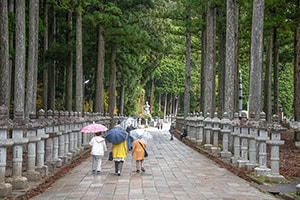
At 1pm the day of our arrival, we met our guide near Kongobuji Temple. Kongobuji is the headquarters / main temple of the Shingon sect of Esoteric Buddhism. The temple is a beautiful building on the walkway to the cemetery and religious buildings we would visit that afternoon. After Nobuhiro Tamara introduced himself (“I am Nobu, your guide”), we had a ceremonial handwashing before walking through the beautiful ancient cedar forest in a light rain.
Nobu was fantastic, and he spoke perfect English. Not only did he make our morning tour so incredible, but it was also the highlight of our visit to Koyasan. He was an affable font of knowledge who described and explained everything we saw.
Setting off, we soon came to Ichi-No-Hashi Bridge, the gateway between the secular and sacred worlds. All visitors should bow before crossing the bridge, said Nobu, to show their respect.
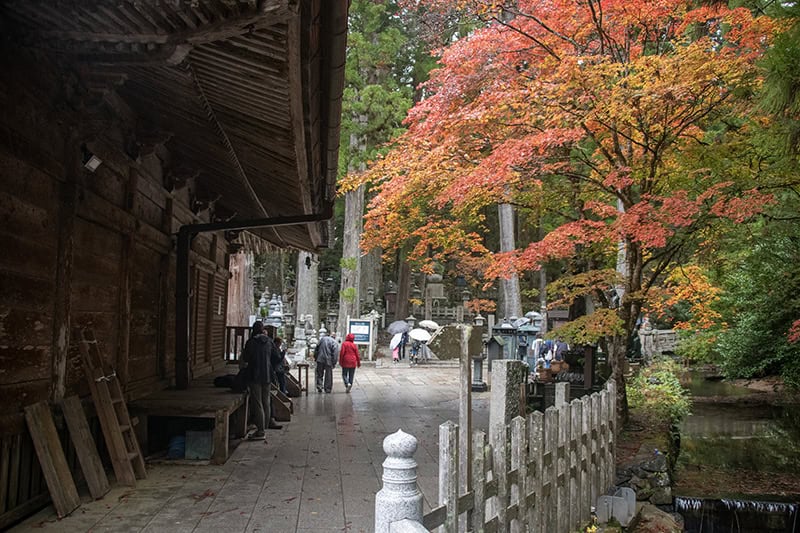
Koyasan, Japan’s Fascinating Cemetery
The sacred, on the far side of the bridge, was Koyasan’s Okunoin Cemetery, the largest in Japan. After crossing the small bridge, my husband and I stood for a moment, fascinated by the beauty about us. It was a beautiful place beneath centuries-old ancient cedars, with colorful temples spread about the forest.
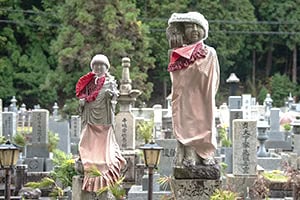
More incredible than the sight, however, was Nobu’s explanation that there are more than 200,000 graves with headstones above ground and an even greater number below ground.
Many tombstones had small doll-like figures on them, which had a red bib tied to it. The bib notes that a prayer has been said to Ojizo-Sama, the Guardian of Children, from someone who has lost a child.
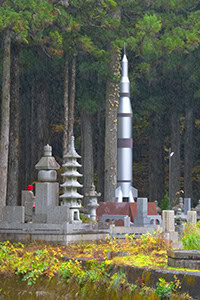
But it’s the tombstones that make it so fascinating.
The tombs of some of the most famous people in Japan’s history, including shoguns, poets, actors, etc., are here. The cemetery also has old stones and statues of the royal family dating back generations.
But the most unusual tombstones are those of notable employees of corporations such as Sony, Toyota, and many others. While some tombstone’s grave markers memorialize the company’s name, others go a bit further. One, for example, has a 20-foot rocket atop it.
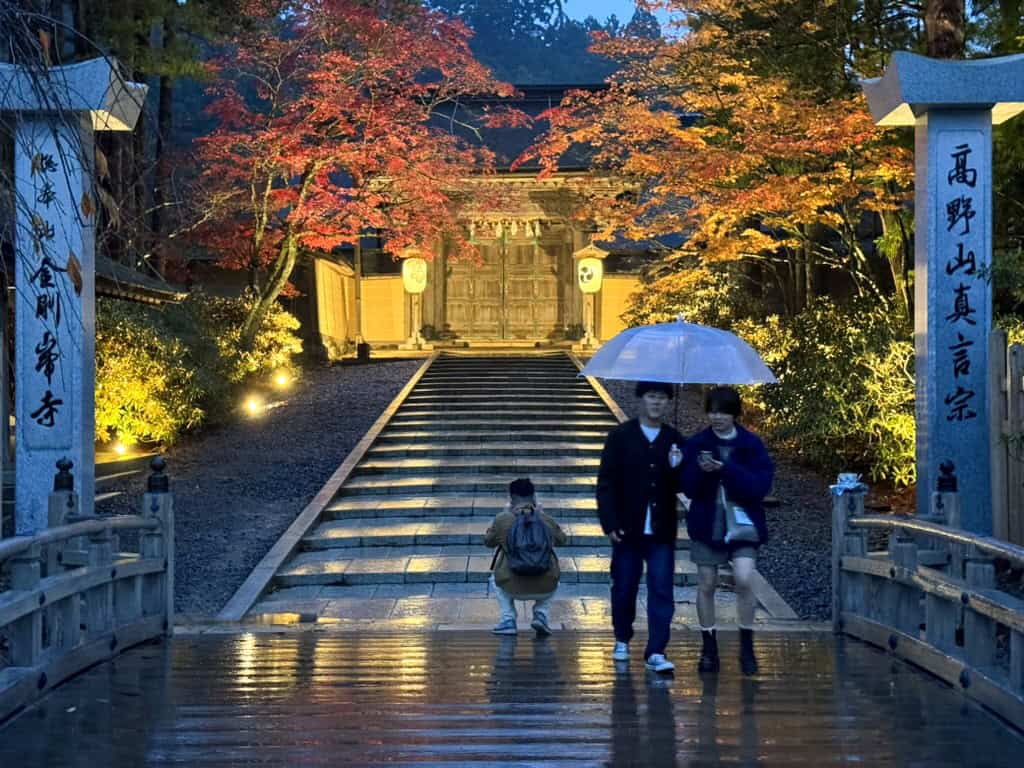
More Fascinating Places
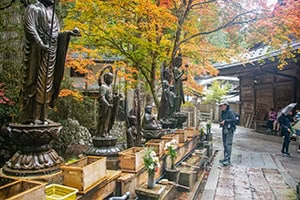
After passing through the cemetery, Nobu continued our tour as we neared the Mausoleum of Kobo Daishi (Kobo Daishi Gobyo). The mausoleum is the focal point of Buddhism and entrance to it is forbidden to everyone, including monks and visitors. Worship is only allowed outside the mausoleum since the monks do not want to disturb Kobo Daishi, who they believe is still resting in the mausoleum in a state of eternal meditation.
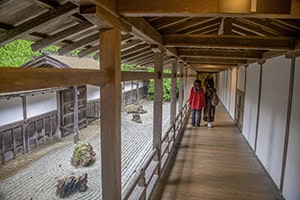
Across from the mausoleum is Torodo Hall, also known as the Hall of Lanterns. Inside it, 20,000 lanterns burn all the time.
Nearby is the fascinating Kongobu-ji, the head temple of Shingon Buddhism. A beautiful place to visit, it has painted sliding doors and Banryutei, the largest rock garden in Japan. Although the garden is beautiful, it’s less ancient than one would think since it was only completed in 1984.
A New Guide, New Sites
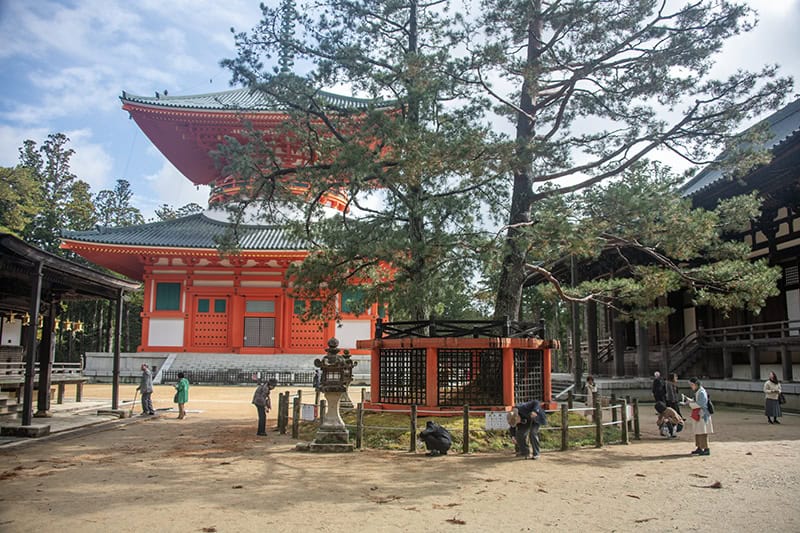
After an overnight at our hotel, Souji-in Temple, we were met the next morning by another guide, Masako Mori. Masako was an excellent guide, and she immediately took us to Danjogaran, an important Buddhist complex near our hotel.
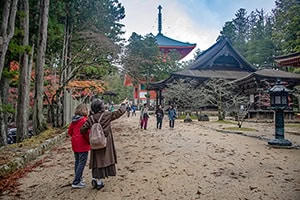
In Japan, at the heart of Koyasan / Mount Koya, you’ll find many sacred buildings in Danjogaran. Along with the sites we visited previously with Nobu, it’s one of the two sacred sites around Mount Koya.
It’s a beautiful area with many sacred halls dedicated to deities, as well as a bell tower and several pagodas. It also is home to beautiful Chumon gate, which was originally built in 815. Unfortunately, it burned down in 1843. Even more unfortunately, it wasn’t reconstructed until 2015 to celebrate Koyasan’s 1200th anniversary. Following tradition, however, the rebuild of the gate was made in the traditional nail-less technique.
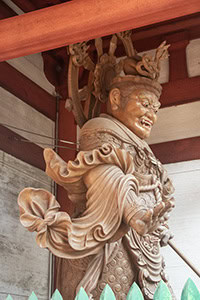
In front of it are statues of its guardians: Dhṛtarāṣṭra (guardian of the eastern direction) and Vaiśravaṇa (god of war).
Another important building in Danjogaran is its 160-foot tall (49 m), bright red, Konpon Daito Pagoda. It’s a fundamental part of the Danjogaran Complex. In fact, “Konpon” means “fundamental” and the pagoda has become a symbol of Kōyasan.
With a square lower story and round upper, it differed greatly from other pagodas at the time. Although it has since become a popular Japanese pagoda design, it has also burned down six times. In 1973, seeking better protection from forest fires, it was rebuilt with concrete with a wood overlay.
Staying At A Monastery
When you visit Koyasan, you can feel you’re back in old-world Japan, including in your lodgings. If you stay at a monastery for the night, you can experience true Japanese-style sleeping accommodations and the Koyasan cuisine.
51 of Koyasan’s temples offer lodging for visitors. If you’d rather not have the total temple experience, you may want to request a toilet en suite. Note also that many temples normally do not accept credit cards, only cash.
Koyasan cuisine is a Buddhist vegetarian diet, which the monks know as Shoujin Ryouri. Since Buddhist followers do not take the life of another living thing, their diet is an elaborate vegetarian cuisine. They believe it to be good not only for the body but also for the mind and soul.
A vital ingredient of this cuisine is tofu, in its various forms and textures. If you have a problem with tofu, you will probably leave hungry – as my husband did. If you enjoy tofu, the presentation’s beauty and the dishes’ creative variety will likely impress you.
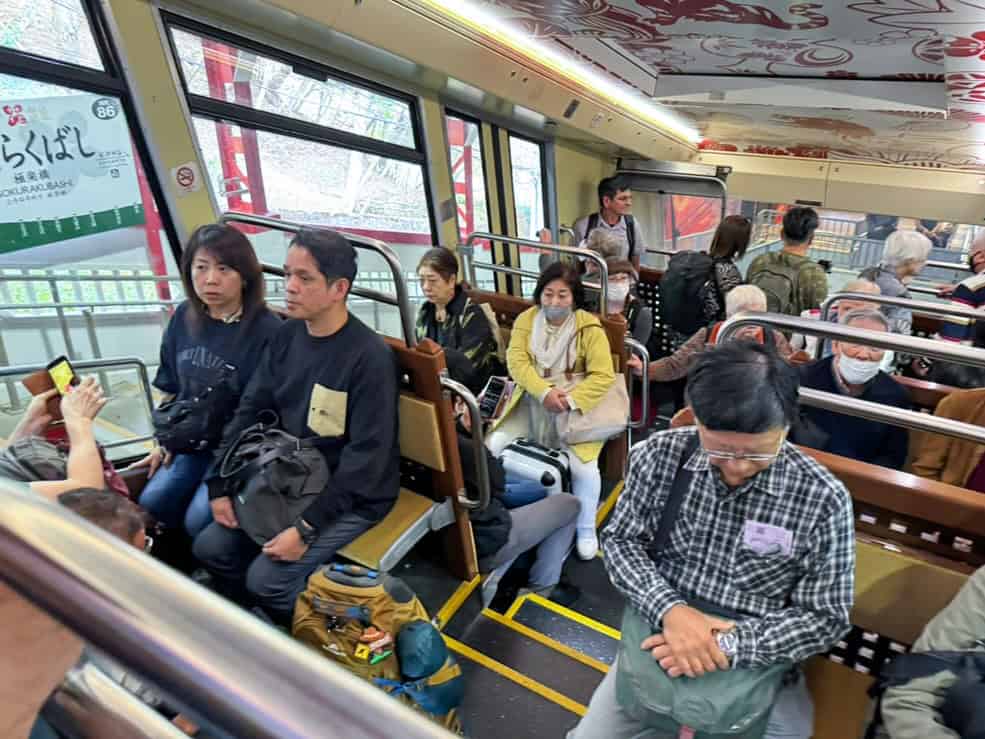
How to Get to Koyasan, Japan
Getting to Koyasan is part of the fun of the trip. You can reach Koyacan from the famous city of Nara—where we departed—or Osaka.
Take the train to Gokurakubashi Station, where you switch to a Swiss-made cable car that takes you directly to Koyasan. The cable car climbs 1,115 feet (340 meters) to Koyasan in 5 minutes, providing a spectacular view of the mountain. After you arrive at the cable car terminal, buses will take you around the small city.
Be aware that in Japan trains adhere to a (very) strict timetable so always arrive at a station early. It will appear to be complicated on paper but everything works like clockwork. At the stations you’ll also find that all signs are in both Japanese and English, making it very easy to navigate the stations.
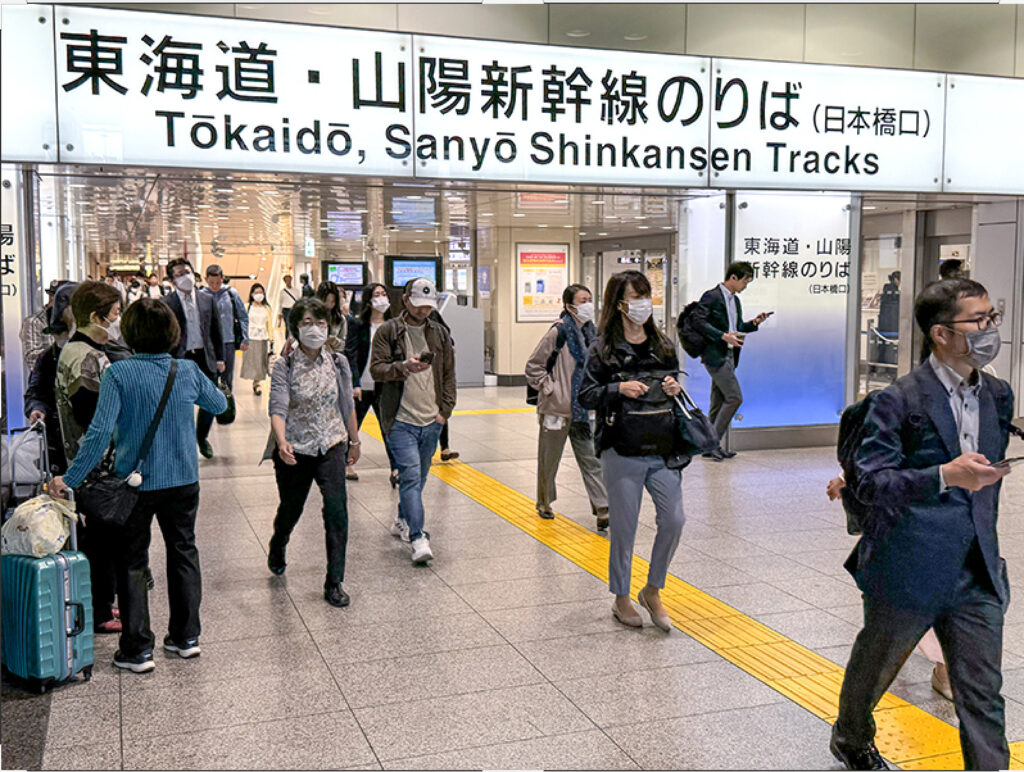
One Final Note
And one final note: the Japanese are exceptionally kind people, as you’ll find during any trip to Japan. A case in point was when we left Koyasan, heading for Osaka.
My husband, Jim, and I were nervous about our upcoming trip from Koyasan to Osaka the next days. On paper it looked a bit difficult, and we were nervous about making the correct train connections. When we asked our guide, Masako Mori, about our trip, she told us she was headed to a town near Osaka that day. She offered to travel with us but would need to get off the train before Osaka.
Needless to say, with her help we made our connections easily. We also found she had changed her ticket to stay with us all the way to Osaka. And once there she even brought us out to the street to show us the right way to our hotel.
Arigatou Masako!

Leave a Reply